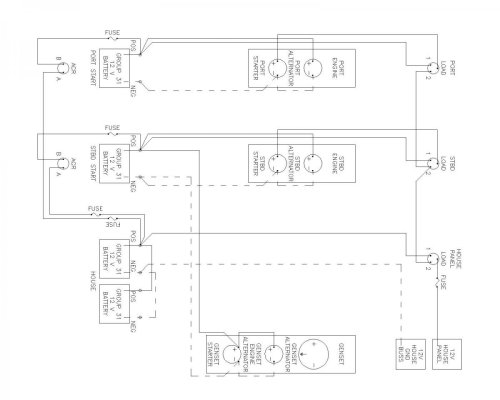DHeckrotte
Guru
I imagine many of us have had a fan belt break on one of our engines, land or sea.
Chugging along last Monday trying ever increasing rpm, now at 2000 rpm, keeping an eagle eye on the starboard's temperature gauge (due to that engine's [previous?] random overheating), all of a sudden the alternator idiot light came on. The ammeter continued to read the amount of charge that it had been. Shortly thereafter the temperature rose. My son diagnosed fan belt and I (thought I'd) shut it down.
He moved the furniture, opened up the hatches, and I shut down the port engine. Hmmm? The starboard engine was still running! It seems I was sloppy shutting it down; I presumably turned the key off before waiting sufficient time for the stop button to stop the engine. Turned the key back on and stopped the engine.
Figured out/realized later that the tach also went to zero without its signal from the alternator. He installed a new fan belt, and found the old one had merely popped off, unbroken. He noted that the crank pulley, the water pump pulley and the alternator pulley are all out of line with each other.
I started the starboard engine and all seems well. Ammeter came up with engine speed as I raised the rpm above idle; held its amps as the rpm came above 1000. So alternator is 'normal'. Tach works. Temp came down.
So! The question of the day is, why did the ammeter continue to read normal amps when the alternator was not turning?
(A few minutes later the port engine quit and required switching from the port tank to starboard, and bleeding, before restarting. That a mystery for another thread.)
Chugging along last Monday trying ever increasing rpm, now at 2000 rpm, keeping an eagle eye on the starboard's temperature gauge (due to that engine's [previous?] random overheating), all of a sudden the alternator idiot light came on. The ammeter continued to read the amount of charge that it had been. Shortly thereafter the temperature rose. My son diagnosed fan belt and I (thought I'd) shut it down.
He moved the furniture, opened up the hatches, and I shut down the port engine. Hmmm? The starboard engine was still running! It seems I was sloppy shutting it down; I presumably turned the key off before waiting sufficient time for the stop button to stop the engine. Turned the key back on and stopped the engine.
Figured out/realized later that the tach also went to zero without its signal from the alternator. He installed a new fan belt, and found the old one had merely popped off, unbroken. He noted that the crank pulley, the water pump pulley and the alternator pulley are all out of line with each other.
I started the starboard engine and all seems well. Ammeter came up with engine speed as I raised the rpm above idle; held its amps as the rpm came above 1000. So alternator is 'normal'. Tach works. Temp came down.
So! The question of the day is, why did the ammeter continue to read normal amps when the alternator was not turning?
(A few minutes later the port engine quit and required switching from the port tank to starboard, and bleeding, before restarting. That a mystery for another thread.)


